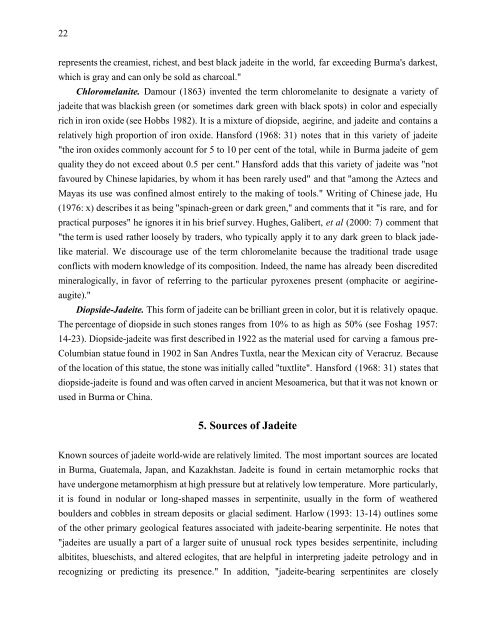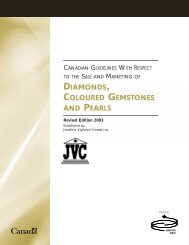JADEITE - Canadian Institute of Gemmology
JADEITE - Canadian Institute of Gemmology
JADEITE - Canadian Institute of Gemmology
You also want an ePaper? Increase the reach of your titles
YUMPU automatically turns print PDFs into web optimized ePapers that Google loves.
22<br />
represents the creamiest, richest, and best black jadeite in the world, far exceeding Burma's darkest,<br />
which is gray and can only be sold as charcoal."<br />
Chloromelanite. Damour (1863) invented the term chloromelanite to designate a variety <strong>of</strong><br />
jadeite that was blackish green (or sometimes dark green with black spots) in color and especially<br />
rich in iron oxide (see Hobbs 1982). It is a mixture <strong>of</strong> diopside, aegirine, and jadeite and contains a<br />
relatively high proportion <strong>of</strong> iron oxide. Hansford (1968: 31) notes that in this variety <strong>of</strong> jadeite<br />
"the iron oxides commonly account for 5 to 10 per cent <strong>of</strong> the total, while in Burma jadeite <strong>of</strong> gem<br />
quality they do not exceed about 0.5 per cent." Hansford adds that this variety <strong>of</strong> jadeite was "not<br />
favoured by Chinese lapidaries, by whom it has been rarely used" and that "among the Aztecs and<br />
Mayas its use was confined almost entirely to the making <strong>of</strong> tools." Writing <strong>of</strong> Chinese jade, Hu<br />
(1976: x) describes it as being "spinach-green or dark green," and comments that it "is rare, and for<br />
practical purposes" he ignores it in his brief survey. Hughes, Galibert, et al (2000: 7) comment that<br />
"the term is used rather loosely by traders, who typically apply it to any dark green to black jade-<br />
like material. We discourage use <strong>of</strong> the term chloromelanite because the traditional trade usage<br />
conflicts with modern knowledge <strong>of</strong> its composition. Indeed, the name has already been discredited<br />
mineralogically, in favor <strong>of</strong> referring to the particular pyroxenes present (omphacite or aegirine-<br />
augite)."<br />
Diopside-Jadeite. This form <strong>of</strong> jadeite can be brilliant green in color, but it is relatively opaque.<br />
The percentage <strong>of</strong> diopside in such stones ranges from 10% to as high as 50% (see Foshag 1957:<br />
14-23). Diopside-jadeite was first described in 1922 as the material used for carving a famous pre-<br />
Columbian statue found in 1902 in San Andres Tuxtla, near the Mexican city <strong>of</strong> Veracruz. Because<br />
<strong>of</strong> the location <strong>of</strong> this statue, the stone was initially called "tuxtlite". Hansford (1968: 31) states that<br />
diopside-jadeite is found and was <strong>of</strong>ten carved in ancient Mesoamerica, but that it was not known or<br />
used in Burma or China.<br />
5. Sources <strong>of</strong> Jadeite<br />
Known sources <strong>of</strong> jadeite world-wide are relatively limited. The most important sources are located<br />
in Burma, Guatemala, Japan, and Kazakhstan. Jadeite is found in certain metamorphic rocks that<br />
have undergone metamorphism at high pressure but at relatively low temperature. More particularly,<br />
it is found in nodular or long-shaped masses in serpentinite, usually in the form <strong>of</strong> weathered<br />
boulders and cobbles in stream deposits or glacial sediment. Harlow (1993: 13-14) outlines some<br />
<strong>of</strong> the other primary geological features associated with jadeite-bearing serpentinite. He notes that<br />
"jadeites are usually a part <strong>of</strong> a larger suite <strong>of</strong> unusual rock types besides serpentinite, including<br />
albitites, blueschists, and altered eclogites, that are helpful in interpreting jadeite petrology and in<br />
recognizing or predicting its presence." In addition, "jadeite-bearing serpentinites are closely









